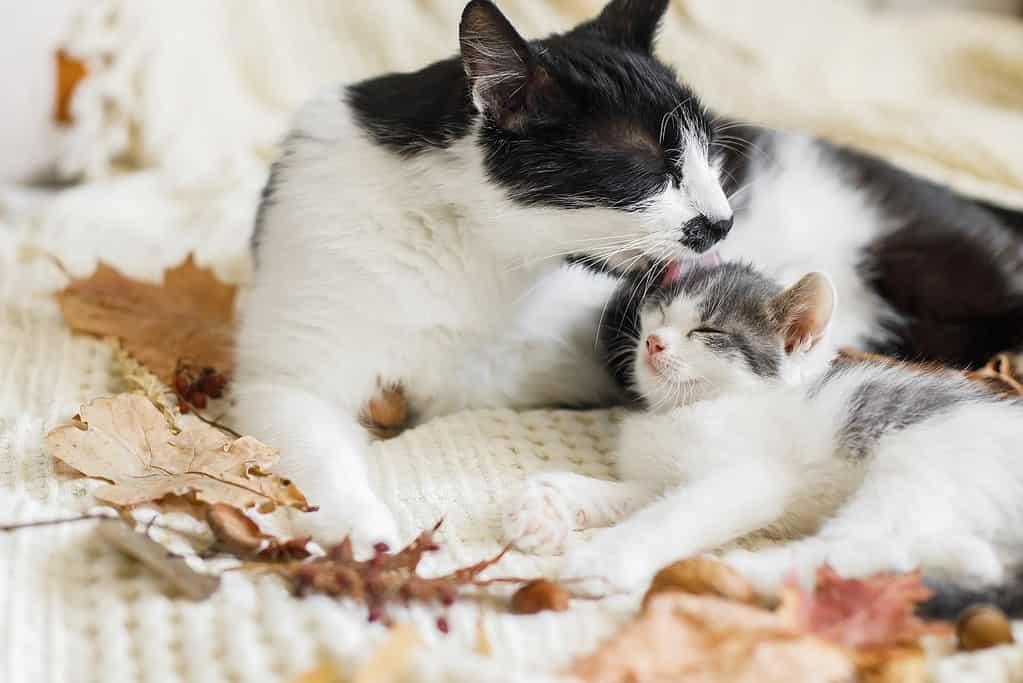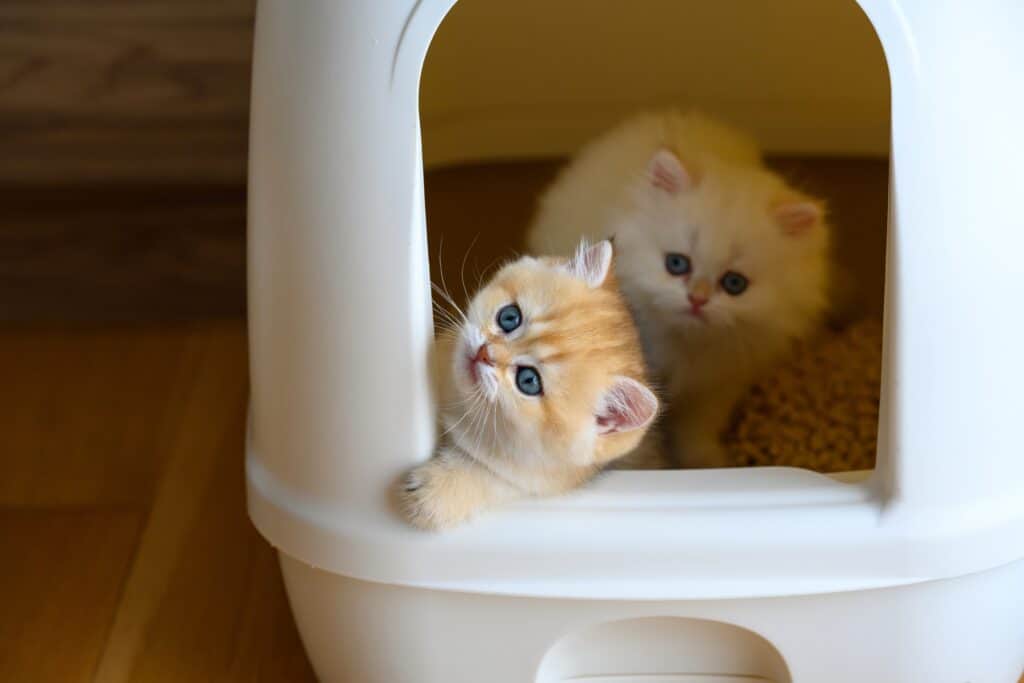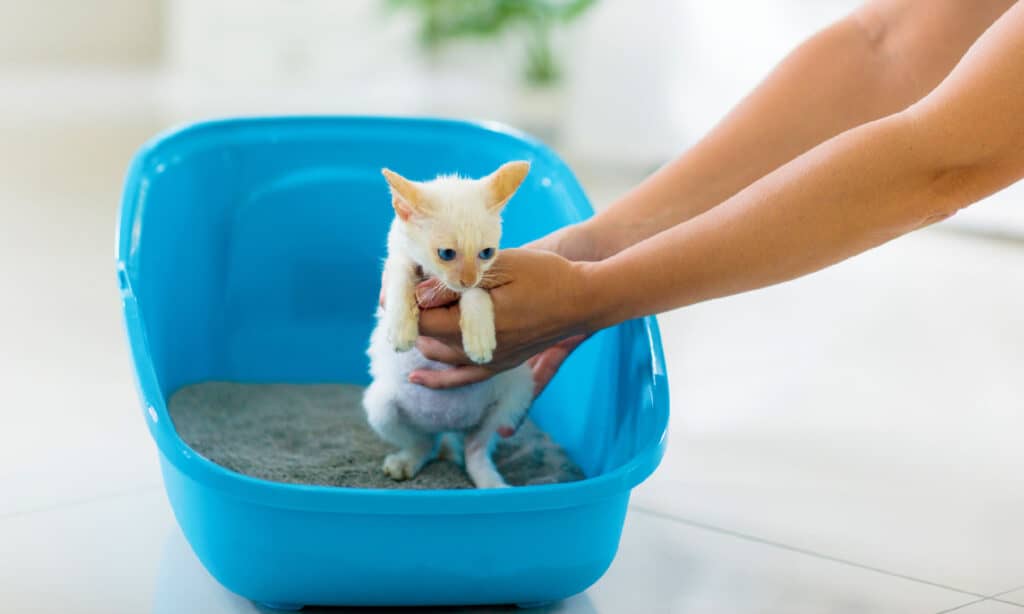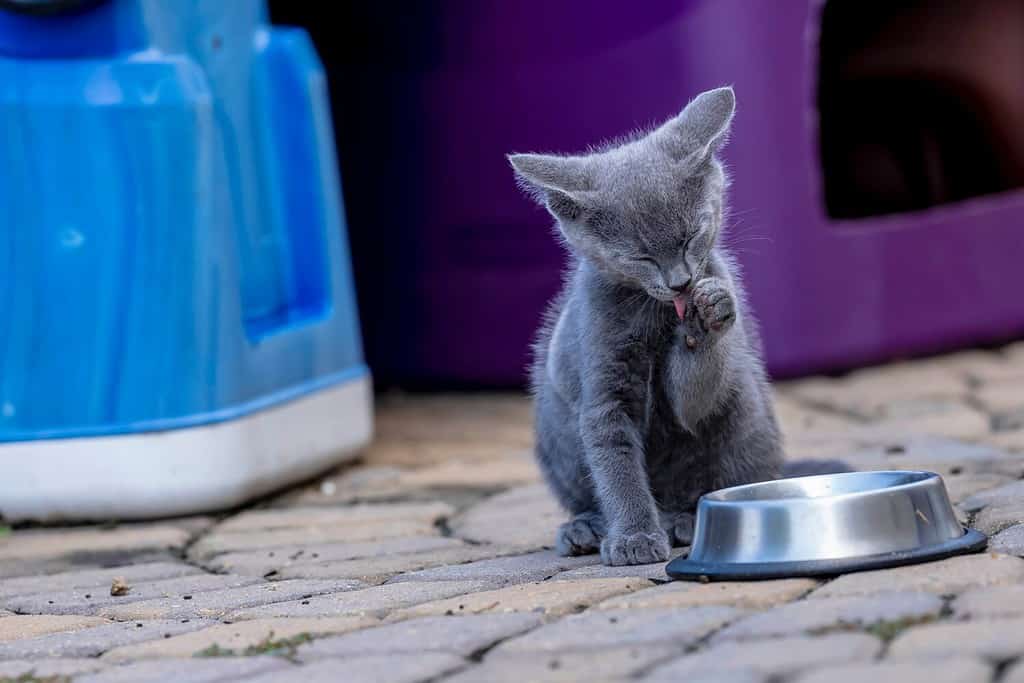How to Litter Train Your Kitten: Timeline and 5 Steps to Take for Success
If you’ve added a kitten (or a few) to your family recently, you’re probably wondering just how to get them on the right path to litter box success. Kittens are some of the most adorable little additions to your family and make wonderful pets. Whether you have adopted a kitten or are taking care of kittens and their mother, it’s a wonderful time to be a pet parent. There is also a steep learning curve to taking care of kittens, especially if this is your first experience with them. But there are a few easy steps you can take to get your kitten litter trained.
When do kittens start using the litter box?

©Bogdan Kurylo/iStock via Getty Images
Kittens generally start using a litter box around 3-4 weeks old. When they start weaning is generally considered a good time to introduce them to a litter box. Before that, kittens are cleaned up by their mothers when they do go to the bathroom. Once they wean, however, their mother prompts them to look somewhere else to take care of their bathroom needs.
Steps to litter train a kitten
Once they are ready, getting your kitten trained to use the litter box is pretty straightforward.
#1 Setup the litter box

©lowpower225/Shutterstock.com
A kitten will likely have a hard time getting into a full-size litter box. The bigger box can also be more intimidating for a tiny kitten. Look for a kitten-friendly litter box that has lower sides and a smaller footprint. Expect to size up as your kitten grows. Covered litter boxes may not be the best idea to start with, since cats in the wild tend to avoid enclosed spaces where they could be trapped by predators. This instinct is still strong even in young domestic cats. It often comes down to the preference of the cat, however, so you can always give them the option of a covered or an uncovered box and see which they prefer.
You can use any cat litter to start with but many cats prefer fine litter that is softer on their paws. Clumping litter is easier on owners and most cats use it without any issues. You might want to try an alternative litter, such as corn-based litter or recycled newspaper pellet litter. Some cats do well with these while others don’t like them (and make it known by going to the bathroom outside of their box). It often comes down to the preference of the individual cat. Introducing them to different types of litter early can help you understand and get to know their preferences.
#2 Make the litter box accessible
Having access to the litter box is one of the most important factors in getting your kitten to successfully litter train. Litter boxes work because they are similar to the places where cats would go in the wild, specifically a separate area where cats can bury their waste in sand, dirt, or another litter-like surface. You should put the litter box in a prominent area to start with so that your kitten can find it and recognize what it is for. Even though cats have better night vision than humans, they’ll still need some light to see and use the box in the dark. A nightlight is often enough to get the job done.
If your home has multiple floors and your kitten has access to all of them, put a litter box on each floor for easy access. Kittens are small and might take more time than expected to get from room to room or floor to floor. Having a litter box easily accessible no matter where they are when they get the urge to go can reduce the likelihood of accidents.
#3 Put them in the litter box

©iStock.com/FamVeld
Once the litter box is set up, bring your kitten to the box to let them see where it is and check it out. They’ll probably sniff around the edges and might even climb in on their own. If they don’t, you can put them in the litter box and show them how to paw at the litter. Repeat this after each time they eat or drink until the kitten uses the litter box. Once they do that once or twice, they’ve probably got the hang of it. Kittens are usually pretty easy to litter train and often just need to know where the litter box is.
For kittens who have their mother living with them, the mother cat might take care of all litter box training for you. It’s important to still set up a kitten-friendly box. You can put it next to the mother’s litter box. You may put it a bit closer to where the kittens tend to hang out. The mother cat will lead the kittens to the box and show them how to use it. Often, this is all it takes for the kittens to get the message that it’s time to take care of their bathroom habits on their own.
#4 Keep the litter box clean
Make sure to scoop waste from the litter box daily to keep it clean. Cats and kittens can get stressed or irritated when their litter box is dirty. This can cause them to look for other places to do their business. Not only does this make more messes for you to clean up, but it is the opposite of what you want them to learn.
#5 Set up a litter box training room
Consider reducing their space to a single room or floor until they master the litter box. This is beneficial for kittens who are easily distracted. Of course, you’ll want to make sure that it is an area where the litter box is easy to see, find, and use. You might even want to set up multiple litter boxes. This gives them as many chances as possible to make the connection. Often once they figure out what the litter box is for, they quickly become adept at making it there when needed. At that point, you can give them free run of the house again.
What is the fastest way to litter train a kitten?

©Esin Deniz/Shutterstock.com
The best and fastest way to litter train a kitten is to let their mother cat do it. Introducing kittens to the litter box is a natural thing that their mother will do, shortly after they start weaning. If the mother is there with the kittens, all you need to do is provide the litter box. She’ll take care of the rest.
If you are filling in for mama cat and training the kitten yourself, you’ll need to lead the kitten to the litter box. You can show them where it is and show them that they can paw at the litter. Because cats in the wild also use a similar method, this is often enough to let the kitten’s instincts kick in. They know that pawing at a soft and sandy place means that it is a good spot for their waste. They can go, bury it, and move on with their day, just like they would in the wild.
How often should I put my kitten in the litter box?
To start with, put your kitten in the litter box after they eat or drink. You can also put them in the box after they wake up if they have been taking a nap. In most cases, doing this a few times is enough for the kitten to learn where the litter box is and what to do when they get there. If your kitten gets distracted easily, you might need to guide them to the litter box more. Doing this a few more times might be needed before they get the hang of doing it on their own. You can always watch them after they eat or drink to see where they go. If they head for the litter box, they’ve probably got things down.
How long does it take to litter train a kitten?

©Grindstone Media Group/Shutterstock.com
Some kittens learn the litter box after just one use. Others can take a few reminders and might need to be placed in the box for a few days. Overall, anything under four weeks is pretty normal. If your kitten gets the hang of the litter box with few or no accidents within four weeks, they’re on track to be great litter box users for good. If it takes longer than four weeks, you might need to offer them a different box, change to a different type of litter, or talk to your vet about other issues that could impact their bathroom habits.
Why is my kitten not using the litter box?

©beton studio/Shutterstock.com
There can be a few reasons why kittens aren’t using the litter box. These can range from trouble learning how to issues with the setup. If the kitten hasn’t mastered the litter box yet, you might want to reduce the distractions in the area. This can mean placing them in a smaller area with multiple boxes until they learn how to go. You should also look at the litter box itself and make sure that the kitten can access it. Move it into a more prominent place to make sure that the kitten knows where it is.
It could also be an issue with the type of litter. As we mentioned earlier, all cats have their own preferences. Some will use just about any litter out there while others are very picky. If your cat or kitten is going to the bathroom right next to the litter box, it’s a good indicator that something about the setup isn’t working for them. They know where the litter box is and they know what to do there. But either the litter, the box itself, or some other factor isn’t to their liking. Try switching to a different litter to see if it helps.
If the kitten was using the litter box and suddenly starts peeing or pooping outside of the box, it might be that they are feeling intimidated by another cat in your home. Some cats will guard the litter box and be territorial. New kittens will back down and not mess with the older cat. In this case, add a litter box to your home so that everyone has access to a bathroom when they need one. Ideally, you’d have one more litter box than you do cats.
If litter box troubles persist, consider getting your kitten checked out by the vet to rule out any medical issues. Vets can also give good advice about things to try to help your kitten litter train.









